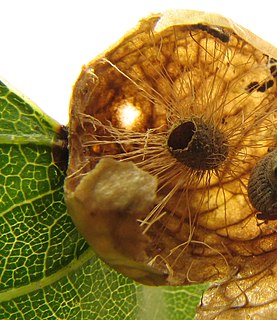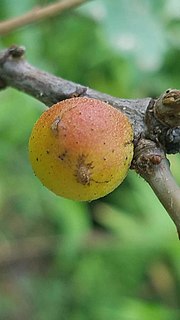
Gall wasps, also incorrectly called gallflies, are hymenopterans of the family Cynipidae in the wasp superfamily Cynipoidea. Their common name comes from the galls they induce on plants for larval development. About 1,300 species of this generally very small creature (1–8 mm) are known worldwide, with about 360 species of 36 different genera in Europe and some 800 species in North America.

Dryocosmus are a genus of gall wasps. They are cyclically parthenogenetic insects that induce galls on plants in the family Fagaceae.

Neuroterus is a genus of gall wasps. Some species produce galls that fall off the host plant and jump along the ground due to the movement of the larvae within.

Leptocybe invasa, the blue gum chalcid wasp or eucalyptus gall wasp, is a chalcid wasp which is the only species in the monotypic genus Leptocybe in the subfamily Tetrastichinae, of the family Eulophidae. It is a gall wasp which causes the formation of galls on a number of species of Eucalyptus, it was described in 2004 after galls were found in river red gums in the Mediterranean and Middle East and has since been found to be a widespread species where its host trees are planted. It is indigenous to Australia.

Andricus is a genus of gall wasps in the family Cynipidae, tribe Cynipini.

Adelaide Local Nature Reserve is in North West London, in the area of Chalk Farm, Primrose Hill, Belsize Park and Swiss Cottage. It is managed by a local volunteer group, the Adelaide Nature Reserve Association, which works with the council to improve the site for wildlife and local community use and enjoyment. The site is a Local Nature Reserve and Site of Borough Importance for Nature Conservation, Grade 1.
Cynipini is a tribe of gall wasps. These insects induce galls in plants of the beech and oak family, Fagaceae. They are known commonly as the oak gall wasps. It is the largest cynipid tribe, with about 936 to 1000 recognized species, most of which are associated with oaks. The tribe is mainly native to the Holarctic. Cynipini wasps can act as ecosystem engineers. Their galls can become hosts of inquilines, and the wasps themselves are hosts to parasitoids.

Acraspis is a genus of gall wasps in the family Cynipidae. The following species are recognised in the genus Acraspis:

Amphibolips is an American genus of gall wasps in the family Cynipidae. There are about 52 described species in Amphibolips.

Andricus kingi, the red cone gall wasp, is a species of gall wasp in the family Cynipidae.
Heteroecus is a genus of gall wasps in the family Cynipidae. There are about seven described species in Heteroecus.

Disholcaspis quercusglobulus, the round bullet gall wasp, is a species of gall wasp in the family Cynipidae.

Disholcaspis is a genus of gall wasps in the family Cynipidae. There are more than 20 described species in Disholcaspis.

Andricus quercusflocci is a species of gall wasp in the family Cynipidae.

Liposthenes glechomae is a species of gall wasp in the family Cynipidae. It is found in Europe and Northern Asia as well as North America where it and its host plant Glechoma hederacea are invasive, non-native species. Galls may appear as small red blemishes on foliage and develop into large green galls nearly as long as one of the plant's leaves.
Liposthenes is a genus of gall wasps in the family Cynipidae. There are at least two described species in Liposthenes.

Amphibolips quercusinanis, known generally as the larger empty oak apple wasp, is a species of gall wasp in the family Cynipidae.

Callirhytis is a genus of gall wasps in the family Cynipidae. There are more than 90 described species in Callirhytis.

Andricus quercuspetiolicola, also called the oak petiole gall wasp, is a species of oak gall wasp in the family Cynipidae. Galls in which the larvae live and feed are formed along the midrib or petiole of white oak leaves.

Philonix is a genus of oak gall wasps in the family Cynipidae. Species in this genus are only known from Canada, the United States, and Mexico. The larvae of Philonix wasps induce galls on white oaks that are typically spherical, soft and fleshy. Galls are usually formed on the underside of leaves. Adult wasps are similar in appearance to species in the genus Acraspis. Many gall wasps have alternate sexual and asexual generations, but this has not been documented in Philonix.

















